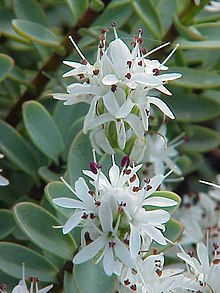Hebe (plant)

Hebe /ˈhiːbiː/[1] is a genus of plants native to New Zealand, Rapa in French Polynesia, the Falkland Islands, and South America. It includes about 90 species and is the largest plant genus in New Zealand. Apart from H. rapensis (endemic to Rapa), all species occur in New Zealand. This includes the two species, H. salicifolia and H. elliptica, that have distributions extending to South America. The genus is named after the Greek goddess of youth, Hebe.
Hebes are widely grown as ornamental plants (see Cultivation below).
Hebe has four perpendicular rows of leaves in opposite decussate pairs. The flowers are perfect, the corolla usually has four slightly unequal lobes, the flower has two stamens and a long style. Flowers are arranged in a spiked inflorescence. Identification of Hebe species is difficult, especially if they are not in flower. The plants range in size from dwarf shrubs to small trees up to 7 metres, and are distributed from coastal to alpine ecosystems. Large-leaved species are normally found on the coast, in lowland scrub and along forest margins. At higher altitudes smaller-leaved species grow, and in alpine areas there are whipcord species with leaves reduced to thick scales.
There are differing classifications for the genus and some botanists now include Hebe, together with the related Australasian genera Chionohebe, Derwentia, Detzneria, Parahebe, Heliohebe and Leonohebe, in the larger genus Veronica (hence its common name shrubby veronica).[2][3][4]
